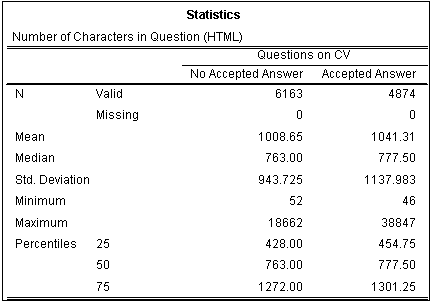I have been going on a bit of a data explorer binge recently, so here are a few stats to bear on the discussion. Here is query I used to pull the data for these tables and graphs. Of most note, I proxy "length of question" via the number of characters (in html) per question (i.e. the QLength variable in the query).
Now this is certainly an imperfect proxy, and I encourage others to do some text munging and improve upon it. But to proceed with imperfection ...
The distribution of question length comparing questions with an accepted answer vs no accepted answer is amazingly similar. Below is a table of some summary statistics, and following that a chart of boxplots for accepted answers and not accepted answers (with question length on a log scale). Labels in the box plots are post ids.


If there is a length of question too long to answer, we have not yet reached it! (That question is a good example of how character length of the html fails as well, it is only long because of a long code snippet, not because the actual question is long, a better procedure would not count such things in question length)
One might also consider not only if the post has an accepted answer, but the number of actual answers the post has received. Again (surprisingly to me) there appears to be little to no relationship between the question length and the number of answers. Below the graph is plotted on what SPSS calls "Safe Log" scale, where values of 0 are assigned to zero on the log scale. The points are also jittered because of extreme striation in the lower count values (over 90% of questions have answer counts 3 or fewer).
It is a bit strange to plot answers on a log scale, but it ends up producing a usefully weird separation in the point cloud. Points near the bottom are posts with no answers, and above have one or more answers.

I encourage everyone to download the data themselves and improve upon my analysis! An easy improvement may be just eliminating code snippets from the question length and seeing if the same results still hold. One might also include a host of other characteristics of the questions in analysis as well.



